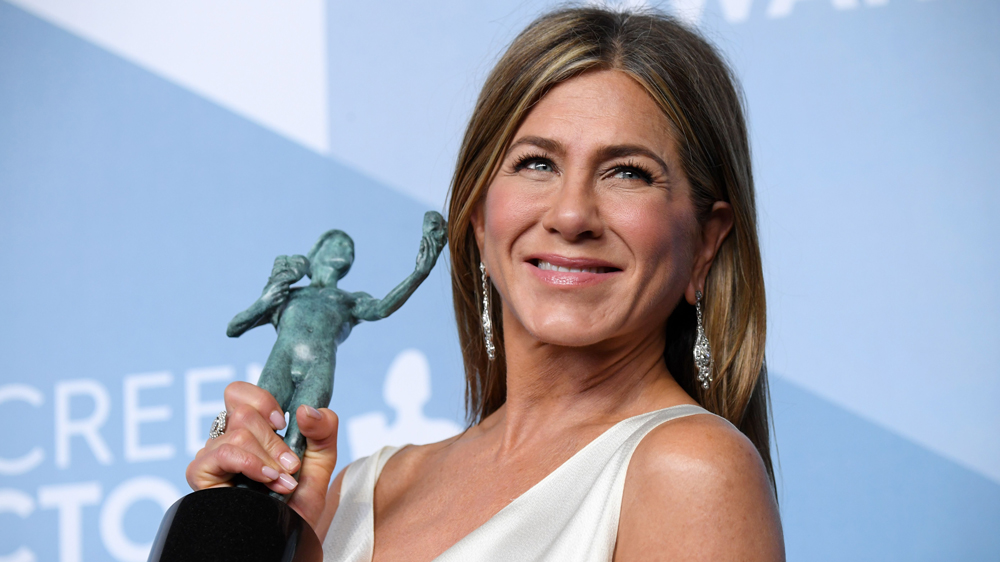Jennifer Aniston and the Rise of Actor-Producers
By Tim Gray
LOS ANGELES (Variety.com) – When Jennifer Aniston won a SAG Award Jan. 19, the mainstream media seized on one fact: She and her ex Brad Pitt were together in the winner’s circle. Woo-woo, hot stuff!
For gossip rags, that’s fun, but this angle misses the bigger picture. First, her award for “The Morning Show” was a nice validation for Apple TV Plus. Second, this was a project on which she and Reese Witherspoon are exec producers, meaning actor-producers have moved beyond the realm of “vanity productions,” as such deals used to be called for performers.
The 21st century has seen a sharp rise in actors with successful production companies. That list includes Sandra Bullock, Viola Davis, Jennifer Lopez, Salma Hayek, Eva Longoria and Nicole Kidman (HBO’s “Big Little Lies,” on which she and Witherspoon are exec producers, remains a gold standard).
Though 2019 Oscar nominations inspired protests for lack of gender diversity among directors, the tallies in the best picture rank are better — not 50-50 yet, but getting there. Eight of the nine nominated films have at least one woman producer. Of the 25 individuals cited, 15 are men, 10 are women. (This might lead you to believe that Hollywood is close to equality, but any aspiring female producer will tell you otherwise.)
Though women in the 21st century are fighting for their place in Hollywood, they were crucial in the early days of filmmaking, including execs and writers such as Anita Loos, Frances Marion, June Mathis and Bess Meredyth, and stars Norma Talmadge, Gloria Swanson, Lillian Gish and Mary Pickford, among them.
In 1916 Variety wrote about the startup of production company Mary Pickford Pictures Corp. A few years later, she joined Charlie Chaplin, D.W. Griffith and her husband, Douglas Fairbanks, to create the game-changing United Artists.
In 1920, Variety wrote that Pickford would star in “Pollyanna,” her first film for UA. Pickford, aka “America’s Sweetheart” even though she was born in Canada,
was 28 when she played the 11-year-old Pollyanna. (Thank God Twitter wasn’t around.) The public didn’t care about her age; it was one of her highest-grossing films. The following year, she starred as both a little boy and his mother in “Little Lord Fauntleroy.” She won the second best actress Oscar for “Coquette,” in which she played a married heartbreaker, a change of pace. And she was a producer.
After Pickford, the Oscar honor roll of actor-producers is led by Jane Fonda, Whoopi Goldberg and Barbra Streisand. In the 1970s, Fonda and Bruce Gilbert formed IPC Films, which produced (alone or in tandem with other companies) “The China Syndrome” and “On Golden Pond,” which earned her Academy Award nominations, and “Coming Home,” for which she won. The company also produced “9 to 5” and “Rollover.”
Goldberg remains a powerhouse, producing multiple projects since 1990 (the year she won for “Ghost”). She has produced work in film, TV and stage, including the Lifetime series “Strong Medicine” (132 episodes), the 2013 Emmy-nominated doc on Moms Mabley, and the Tony-nominated “Sister Act” stage musical. Streisand was exec producer of the 1976 “A Star Is Born,” and producer of “Yentl” and “The Prince of Tides,” all of which were Oscar-nominated.
This year, Charlize Theron got an Oscar nom for Lionsgate’s “Bombshell,” on which she was a producer. She also was a producer of “Monster,” for which she won.

